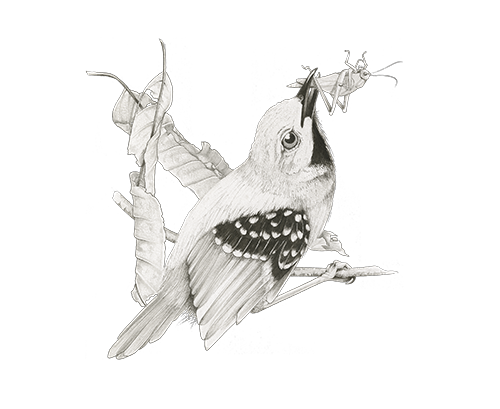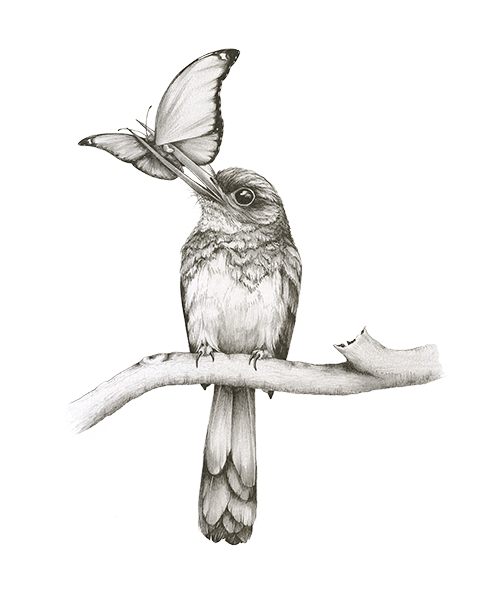By Thomas W. Sherry
Linked paper: Insectivorous birds in the Neotropics: Ecological radiations, specialization, and coexistence in species-rich communities, by T.W. Sherry, C.M Kent, N.V. Sánchez, and Ç.H. Şekercioğlu, The Auk: Ornithological Advances.
We can be easily overwhelmed by the biological complexity of the tropics; visitors understandably flock to the eye-candy, the dancing manakins, colorful tanagers and quetzals in fruiting trees, and the hummingbirds visiting vibrant tropical flowers. With so many distractions, we can easily overlook the diverse tropical insect-feeders that often lurk in the darkest rainforest hideouts, sporting drab plumages and non-descript voices. In the Neotropics—the New World tropics—these insectivores are disproportionately suboscines, i.e., non-songbirds, as if to emphasize their “sub-ness.” However, the fascinating ecology and evolution of Neotropical avian insectivores, which comprise more than 60 percent of all bird species in the Neotropics, are profoundly informative, even if often overlooked.
Neotropical insectivores make up for their inconspicuousness with dramatic feeding specializations; iridescent jacamars chase Morpho butterflies, sit-and-wait puffbirds subdue large insects, professional army ant followers snatch the arthropods fleeing the ants, and bustling antwren flocks—including birds whose names (genus Epinecrophylla) hint at how they specialize, in this case farming suspended dead leaves for juicy insects. But why these specializations? Niche theory asserts that the stable tropics have allowed specialization via narrow niches and large niche spaces to accommodate the high tropical species richness, explaining the “Latitudinal Diversity Gradient.”

Neotropical insectivores tell a different story than the traditional niche theory. These feeding specializations make sense when recognizing two important facts about the tropics. First, these birds are engaged in arms races, many tens of millions of years in the making, with their insect prey, which have evolved effective defenses. Second, many insectivorous birds coexist locally, with sometimes more than 100 species living together in lowland Amazonian rainforest. These birds eat many of the same insects, including beetles and katydids. For example, some antwrens scour suspended dead leaves for many of the same katydids that woodcreepers search for myopically on tree trunks and that army ant swarms scare up for some antbirds, exacerbating diffuse competition for food. These two facts boil down to the surprising inference that food is effectively scarce, year-round. Many of the most specialized Neotropical insect feeders have evolved their specializations to detect, capture, handle and subdue, and digest the scarce, if diverse, tropical organisms that are correspondingly adept at evasion.
If Neotropical insects are so “scarce,” then the ability to economize with whatever food birds can get should select for physiologically conservative, low metabolic rates, just as sloths exhibit among mammals. This metaphorical tropical food desert may explain why many Neotropical birds disperse poorly, likely contributing to their geographical population differentiation, and perhaps even to elevated speciation rates in the Neotropics that reinforce tropical species richness.
The relative stability of Neotropical forests, coupled with the geological complexity including the Andes mountains and vast river systems feeding the Amazon, have contributed to relatively high speciation rates (the tropics as an evolutionary “cradle”), and to relatively low extinction rates (the tropics as an evolutionary “museum”) in many Neotropical bird families. It follows that tropical species richness, combined with the bird-insect arms race, are the ultimate causes of the feeding specializations, rather than tropical stability allowing narrow niches within expanded niche volume. In other words, Neotropical insectivores tell a story of phylogenetic diversity driving specialization and coexistence, rather than specialization allowing species richness via ecological coexistence. Aligning what we have learned about Neotropical insectivores with other evolutionary approaches, such as the coevolution of birds and herbivorous insects with plants, we’ve taken a similar evolutionary approach to understanding Neotropical bird diversity. The specializations we observed also explain why tropical insectivores are so sensitive to human disturbances, such as habitat loss and fragmentation.
Our systematic survey of the phylogenetic distribution of Neotropical insectivores and a review of arthropod anti-predator defenses comprise two supplementary documents, which led to the recognition of striking patterns, such as adaptations by many of the most specialized insectivores to exploit the anti-predator adaptations of their prey. Recognizing the stunning variety, yet repeated patterns of how Neotropical insectivorous birds are adapted behaviorally and morphologically to acquire their prey, provided the major impetus for the ideas described in our paper.
About the artist

Margaret (Meg) Maurer did these biological illustrations from September 2018–February, 2019, in collaboration with Dr. Thomas Sherry of Tulane University. These pen-and-ink illustrations magnificently capture these birds’ postures, plumage, prey, and many other critical details relevant to each species’ biology—and in a way that photographs cannot. These works attest to Meg’s artistic ability to capture the sheen of a butterfly’s wing and the light in a bird’s eye.
Meg grew up in Forest Lake, Minn., began her studies at Tulane University in August 2015, and was graduated posthumously in May 2019 with a B.S. in Ecology and Evolutionary Biology and a Spanish Minor. Her undergraduate studies abroad as a junior led her to live and learn in the critically threatened dry forests of western Ecuador, where she discovered the beauty and informative power of scientific illustration. Fluent in Spanish, Meg took a medical illustration class at Universidad San Francisco de Quito, Ecuador; otherwise, she taught herself to draw through observation, practice, persistence, and patience. Through her artwork, writing, and leadership roles, she sought to communicate and generate discussions about ecology and evolutionary biology concepts to help bridge disciplines, learning styles, and languages. Meg was 21 years old when she died unexpectedly on March 5, 2019. Today, Meg’s enthusiasm for learning and passion for conservation, evident in her artwork, challenge us to make a difference in the world.



Love this! Meg’s illustrations are perfection! This is a great tribute to Meg and everyone else that contributed to this!
Norma Maurer,
I’m only just seeing your comment now. Yes, Meg’s illustrations are perfection, and contributed immensely to this paper, and will contribute to ongoing work on these birds!